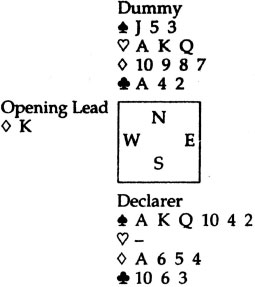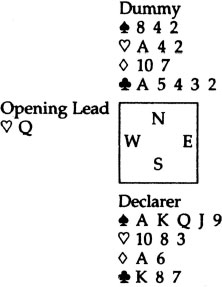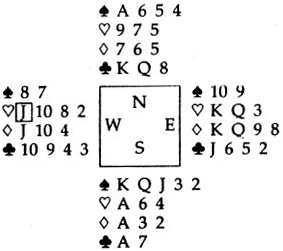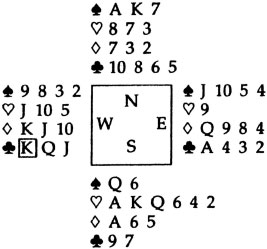
CHAPTER 23
Discarding Losers
The Acol system, popular in Britain, got the name Acol because it was first developed in a house in Acol Road, London.
In the last chapter, we saw that the declarer could get rid of losers by trumping them in the dummy. In this chapter, we are going to consider another way for the declarer to get rid of his losers. This time the extra strength in the dummy, rather than the shortness, is used to eliminate some of the losers in the declarer’s hand. You can go through four steps when thinking about using the dummy’s strength to get rid of your losers. First, you again have to recognize the hand patterns where the opportunity exists. Second, you may have to play a side suit several times before you can use it for throwing away a loser. Third, you may have to look for opportunities to create extra winners in the dummy through promotion, length in a suit or the finesse. Finally, you may have to arrange transport, or entries, to the dummy so that you are in a position to put the plan into action. Let’s look at each of these steps in turn.
Recognising hand patterns
It is important to spot the characteristics in your hand and in the dummy that afford the opportunity to throw away losers from your hand on the dummy’s extra strength. Look for a side suit in which there are more cards in the dummy than there are in your hand. This is the reverse of the pattern you wanted when you were trumping losers in the dummy, where you wanted more cards in your hand than in the dummy. After you have located a suit that is longer in the dummy, look to see whether there is enough strength in the suit to enable the dummy to win a trick while you are throwing away a loser from your hand. Consider this hand where spades are trumps.

Find the suit with more cards in the dummy than in the declarer’s hand. There are three hearts in the dummy and none in your hand. Next consider the strength of the heart suit. Since there are three winners, you can use this extra strength to get rid of three losers in your hand. After the opponents’ trumps are drawn, you can cross to the dummy’s  A and discard three of your losers on the hearts.
A and discard three of your losers on the hearts.
Here are three other possible layouts for the heart suit. Which ones offer a chance to throw away a loser from your hand on the dummy’s extra strength?

The pattern in the first example is worth looking at since there are more cards in the dummy than there are in your hand. There is not, however, the extra strength needed to throw away a loser. After the  A and
A and  K are played, the opponents have the remaining winners in the suit. In the second example, there is the strength in the suit and the suit is unevenly divided, but you cannot throw away a loser in your hand. The pattern you are looking for is one that has more cards in the dummy. The third example offers an opportunity to get rid of a loser from your hand. After the suit has been played three times, you have none left and can throw a card, a loser, from another suit. (Since the side suit has to be played so many times before you are in a position to get rid of a loser, it would be a good idea to first draw the trumps.)
K are played, the opponents have the remaining winners in the suit. In the second example, there is the strength in the suit and the suit is unevenly divided, but you cannot throw away a loser in your hand. The pattern you are looking for is one that has more cards in the dummy. The third example offers an opportunity to get rid of a loser from your hand. After the suit has been played three times, you have none left and can throw a card, a loser, from another suit. (Since the side suit has to be played so many times before you are in a position to get rid of a loser, it would be a good idea to first draw the trumps.)
Taking advantage of the dummy’s extra winners
You are the declarer in a contract of 4  and count your losers in these two suits:
and count your losers in these two suits:

In diamonds, you look to have one loser in your hand but a glance at the dummy shows that there is plenty of strength there to take care of it. You have two club losers. When you look to dummy’s clubs, there is no help in the club suit. The diamonds, however, offer an opportunity for you to eliminate your club losers by throwing them on the second and third diamond trick.
You have taken advantage of a side suit that is unevenly divided between your hand and the dummy. When you were trumping a loser in the dummy, you wanted to work to eliminate all of dummy’s cards in the side suit. When you are throwing away losers, you want to work toward getting rid of the declarer’s cards in the suit. Here is another example:

You have two diamond losers in your hand but look to the dummy to see that the  A and
A and  K can take care of them. The dummy’s
K can take care of them. The dummy’s  K in combination with your
K in combination with your  K eliminate two of the losers in that suit, but there is still one left. The diamonds offer a chance to eliminate your club loser. Play the three top diamonds and, on the third round, discard a club from your hand.
K eliminate two of the losers in that suit, but there is still one left. The diamonds offer a chance to eliminate your club loser. Play the three top diamonds and, on the third round, discard a club from your hand.
Whenever you are in a trump contract, look for opportunities to get rid of losers. Your first step is to identify side suits which are unevenly divided between your hand and the dummy. In the example above, the diamonds were unevenly divided. On the third round, because you had no diamonds left in your hand, you had an opportunity to discard a club, a loser in another suit.
Look at the effect this has. Now your clubs are no longer 3–3 and, when the third round is played, you are able to trump it, resulting in no losers in the club suit.
Developing extra winners in the dummy
There are times when there are more cards in the dummy than in your hand and, although there are not immediate winners, the suit offers possibilities. You can develop extra tricks in the dummy through promotion, length in a suit or by using the finesse.
Developing extra tricks through promotion
Let’s look again at two side suits, clubs and diamonds. Hearts are trumps.

You have one diamond loser and one club loser. Consider what these two suits will look like if you lead a diamond to the dummy’s  J to drive out the opponents’
J to drive out the opponents’  A:
A:

Look for your unevenly divided side suit. There is an extra diamond in the dummy. Therefore when you play the suit for the third time, there will be a chance to discard a loser from another suit, your small club. Now, you end up with only one loser, the  A. This time, you had to promote your winners before they could be used to get rid of a loser.
A. This time, you had to promote your winners before they could be used to get rid of a loser.
Establishing a winner through length
We saw earlier on, when playing in no-trump contracts, that small cards can be turned into winners when they are part of a long suit.
Consider this layout:

There are eight combined cards in the suit and the odds favour them being divided 3–2. This means that, after three rounds of the suit have been played, the dummy’s remaining two small cards will be winners and the declarer will have no cards left in the suit.
There are other considerations when you are looking to your small cards for winners in the above layout. Because you can only throw away a loser on the fourth round of the suit, you would have to draw the opponents’ small trumps so that they do not use them to win a trick by trumping an established winner. You also have to be able to get to the winners in the dummy. You might have an entry you can use in another suit or you may have to give up a trick early, keeping one of your high cards in the suit as an entry, as discussed in Chapter 17. Nevertheless, if you can turn those two small diamonds into winners, it is worth going through all those steps. Look at this idea in a complete hand. You are in a contract of 4  and the lead is the
and the lead is the  Q:
Q:

Go through the plan. You can afford three losers in a contract of 4  . You have no spade losers, two heart losers, a diamond loser and a club loser. You want to eliminate one of your losers. What are your options? You don’t have more cards in your hand than you do in the dummy in any side suit, so you cannot trump any losers in the dummy. Instead, look for the pattern to throw away losers. You have more clubs in the dummy than you do in your hand. Since there are two more clubs, you have a chance to throw away two losers.
. You have no spade losers, two heart losers, a diamond loser and a club loser. You want to eliminate one of your losers. What are your options? You don’t have more cards in your hand than you do in the dummy in any side suit, so you cannot trump any losers in the dummy. Instead, look for the pattern to throw away losers. You have more clubs in the dummy than you do in your hand. Since there are two more clubs, you have a chance to throw away two losers.
After winning the first trick with the  A, draw the opponents’ trumps. Next, take the
A, draw the opponents’ trumps. Next, take the  K and give up a club trick, leaving the
K and give up a club trick, leaving the  A in the dummy. What can the opponents do? They can take their two heart tricks but, whatever they lead next, you can win the trick. You can play your remaining club and win the trick with your carefully preserved
A in the dummy. What can the opponents do? They can take their two heart tricks but, whatever they lead next, you can win the trick. You can play your remaining club and win the trick with your carefully preserved  A. You are in the dummy and, if the suit has split the way you expect, 3–2, you are in a position to play one of your club winners and throw away your diamond loser.
A. You are in the dummy and, if the suit has split the way you expect, 3–2, you are in a position to play one of your club winners and throw away your diamond loser.
Establishing a winner through the finesse
Another way of establishing an extra winner is through the finesse. Consider this example. Hearts are trumps and we are looking at two side suits, clubs and diamonds:

You have a small diamond in your hand but the  A in the dummy will take care of that. You have one club loser after the
A in the dummy will take care of that. You have one club loser after the  A and
A and  K have been played. Where could you get rid of the club loser? Look to the diamonds, your unevenly divided suit. Although you don’t have a sure winner, there is a possible winner with the
K have been played. Where could you get rid of the club loser? Look to the diamonds, your unevenly divided suit. Although you don’t have a sure winner, there is a possible winner with the  Q. Play your
Q. Play your  4 towards the ace-queen combination. If your finesse against the
4 towards the ace-queen combination. If your finesse against the  K is successful and the
K is successful and the  Q wins the trick, you can play your
Q wins the trick, you can play your  A and throw away a small club. Now you have only two clubs in your hand and when the suit is played a third time, you can trump.
A and throw away a small club. Now you have only two clubs in your hand and when the suit is played a third time, you can trump.
It is important to look not only at the immediate chance to discard losers on the dummy’s extra winners but also down the road to see what winners could be developed through promotion, length or the finesse.
Getting to the dummy
If you are planning on throwing away a loser on an extra winner in the dummy, you have to be sure to have an entry to the dummy. Let’s look at one side suit, this time the spades, since hearts are trumps:

Once the  A has been played, you have two extra winners in the dummy, if you can get to them. You have to look to your other suits and try to preserve an entry so that, after the
A has been played, you have two extra winners in the dummy, if you can get to them. You have to look to your other suits and try to preserve an entry so that, after the  A has been played, you have transport to your promoted
A has been played, you have transport to your promoted  Q and
Q and  J.
J.
Summary
One way to get rid of a loser in a declarer’s hand is to throw it on a winner in the dummy. You can recognize this opportunity by:
• Looking for a suit that has more cards in the dummy than in your hand.
• Realising that you will probably have to play the side suit more than once before you are ready to throw a loser away. Whenever possible, you will want to draw the opponents’ trumps first.
• Looking for opportunities to establish extra winners in the dummy through promotion, establishing small cards in long suits or the finesse.
• Looking ahead so that you have an entry in the dummy to get to the winners when you are ready to discard your losers.
Over Zia’s shoulder
Hand 1 Dealer: North

|
N |
E |
S (Zia) |
W |
|
Pass |
Pass |
1 |
Pass |
|
2 |
Pass |
4 |
Pass |
|
Pass |
Pass |
We can only afford three losers. Let’s work together to see if we can hold ourselves to that number.
Solution to Hand 1:
Contract: 4

|
S |
Well, we decided we needed to lose no more than three tricks. |
|
T |
Our tally tells us that we could possibly lose two hearts and two diamonds. |
|
O |
What can we do? Is there any extra strength in the dummy that can be used? To recognize these opportunities we have to look for a side suit that has more cards in the dummy than it does in our hand. The clubs fit that description. First, we plan to draw the trumps; we have nothing to lose by doing that since we don’t give up the lead and we don’t need the trump suit for entries or to trump any losers from our hand. |
|
P |
Let’s play the clubs carefully; first the |
Hand 2 Dealer. East

|
N |
E |
S (Zia) |
W |
|
Pass |
1 |
Pass |
|
|
1NT |
Pass |
3 |
Pass |
|
4 |
Pass |
Pass |
Pass |
Our partner has bid aggressively but we have reached a good contract. West always seems to have an easy lead! Let’s play the hand.
Solution to Hand 2:
Contract: 4

My immediate reaction is that I like the contract and expect to make it. So let’s stop to make our plan.
|
S |
We can afford three losers. |
|
T |
We have two diamond and two club losers, one too many. |
|
O |
Do we have any extra strength in the dummy? The |
|
P |
There is one catch. Look at the spades. What would happen if you first lead the |
Hand 3 Dealer: East

|
N |
E |
S (Zia) |
W |
|
Pass |
1 |
Pass |
|
|
4 |
Pass |
Pass |
Pass |
The bidding is natural, simple and to the point. Can the play be similar?
Solution to Hand 3:
Contract: 4

|
S |
We can afford only three losers. |
|
T |
Our tally tells us that we have a heart loser, a diamond loser and two club losers. One too many. |
|
O |
Before we go any further, look at the side suits that are unevenly divided. There are more hearts in the dummy than in our hand. Remember, it doesn’t do much good to trump in our hand since we are trumping with a card we had already counted as a winner. To be effective, we should be trumping in the short hand. So, when there are more cards in the dummy than in our hand we are looking for an opportunity to throw away a loser. Does the heart suit offer that possibility? Maybe not on the first trick but, if we drive out the |
|
P |
That’s a good plan. So, we draw the trumps – since there is no reason not to – and play the |